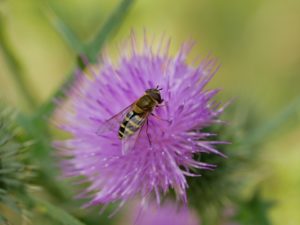
Good day. It is sometimes interesting to watch various funny situations from the outside.
I remember how near me one girl saw a wasp and began to run away from her with loud cries for help. She thought it was a bee, and their bite was deadly.
The nuance of the situation is that at first glance it is not so easy to determine the exact form of insects flying around you. Want to know how to distinguish a bee from a wasp? What are the main differences between them? Now I will discuss in detail all the important points in the article below.
The content of the article:
- 1 Difference between bee and wasp
- 2 What is the difference between a wasp and a bee
- 3 What is the difference between bees and wasps? What does a bee look like?
- 4 How to distinguish a bee from a wasp?
- 5 Honey bee and common wasp
- 6 What is the difference between wasps and bees
- 7 Differences and similarities of wasp, bee, and bumblebee
- 8 Vegetarians and predators
Difference between bee and wasp
There is such a legend that the wasp created the devil, and the bees - God. Following the legend, it is thanks to the blessing that the bees are on guard of human health, supplying such important and necessary components of many medicines as honey, wax, propolis.
And yet, the similarity of these two insects leads to confusion, which we have to figure out.
Appearance
If you ask a child who is in front of him, a wasp or a bee, he will most likely get confused. But adults are often unable to distinguish between a bee and a wasp. And, nevertheless, there are many external differences in these insects.
Bees belong to the order Hymenoptera superfamily Apoidea. They look as follows: the body is somewhat rounded, covered with villi. The bee, like many similar insects, has yellow-black stripes on the body, a muted color.
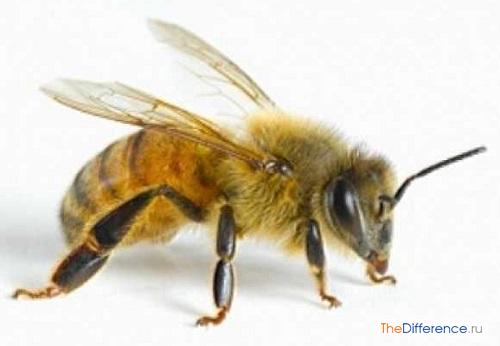
The wasps do not have a strict scientific definition; they include those from the suborder of stalked and bellied, which cannot be attributed to bees or ants. Wasps have a long body, which is tightened in the chest area. The body of the wasps is smooth, without villi. The color of the wasp is similar to a bee - the same stripes, but only bright, noticeable.
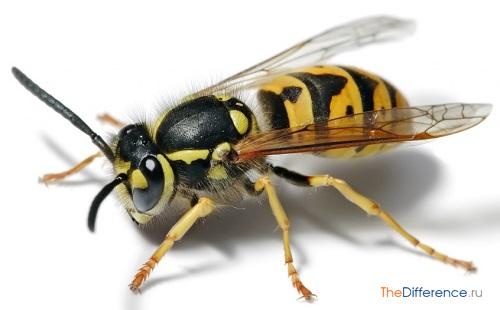
Life activity
Bees by nature belong to toilers. They are ready to work endlessly for the benefit of the hive. By collecting nectar from flowers, bees produce many useful products that are used in pharmaceuticals and human nutrition. Honeycombs of a bee erect from the wax developed by them.
Nutrition of wasps is quite diverse. They do not disdain either fruit or nectar. The diet of wasps also includes delicacies, which include flies and other small insects.
Behavior
In case of danger, the bees sting, but only if they are attacked first. In this way they protect the hive. After the bee stings, it dies, leaving a sting in the body of the opponent.
In the family of bees there is a certain hierarchy, the highest level in which the queen bee is. It is about her well-being that worker bees take care of. In winter, she creates all the conditions for a comfortable existence.
In addition to the sting, the wasp uses a jaw apparatus for defense against opponents, which, in principle, is uncharacteristic for insects of its family. The hornet's uterus spends the winter alone, she does not have assistants and guards. Alone, she lays larvae and builds a nest.
conclusions
- A bee has a more rounded shape. The cover has villi, the color is muted. The wasp, on the contrary, has a smooth elongated body and bright colors.
- Bees produce healthy products: wax, honey, propolis. Wasps do not produce any healthy products.
- Bees are not the first to attack, wasps by nature are predators, they are able to sting for no apparent reason.
- After the bee stings, it dies. Wasps are able to sting many times, and in addition bite using the jaw apparatus.
- Bees feed exclusively on pollen, while wasps are more diverse.
The queen bee is surrounded by care from other members of the family, while the aspen queen is forced to take care of itself.
What is the difference between a wasp and a bee
Many have heard the legend about the creation of bees by God, and the wasps by the devil. This separation is based on the fact that bees create honey, taking care of human health, and wasps collect garbage from the garbage and suffer a lot of diseases. So what is the difference between a wasp and a bee?
Externally, these insects are very similar. The most interesting thing is that the child can easily confuse these "buzzers". But in fact, these insects belong to different orders and differ significantly in habits, habitat.
Bees belong to the hymenoptera order, and wasps are difficult to enroll in a specific group. Therefore, they were attributed to the stalk-bellied, which do not belong to ants and bees. Bees drink dew, and their evil "girlfriends" quench their thirst with anything.
Differences in insect coloration
Insects have a color difference. On the abdomen of the toiler there are dark and bright stripes, but their contours are blurred. The “fiendish creature” has distinct, yellow and black stripes. The bee's body is covered with villi, the wasp, in turn, is completely bald.
The abdomen of the toiler has a rounded shape and resembles a stomach. In a wasp, the body is divided into two parts in the chest area. The lower part is thin and has an oblong shape.
Habitat and livelihoods
Bees are classified as toilers. From morning till night they collect nectar, build honeycombs. The most interesting thing is that the storages for collected honey are also made by bees from their own enzymes. The glands on the paws produce a kind of honey glue that connects pieces of wax, so the mass resembles a building mixture.
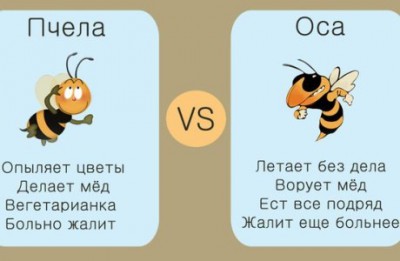
"Devil creatures" do not produce and do not produce. They can be safely considered parasites, as they build nests from waste and feed on anything. Their diet consists of such products:
- garbage from landfills;
- small insects;
- carrion of birds and animals;
- Fresh and rotten fruits and vegetables.
As you can see, wasps eat very diverse, unlike bees. Due to the constant stay in landfills on the legs of these insects, a lot of pathogens of various diseases live. Accordingly, after a bite, infection or attachment of a bacterial infection is possible. You can distinguish insects from the picture.
What are the differences in stressful situations?
Workers take care of their uterus and constantly protect the hive. But they never attack first in case of danger. Only if you decide to get into their housing, then get ready for an attack.
That is why it is recommended not to move if a wasp flies near you. She will quickly respond to your movements and brushing off a bite. After a bite, she does not die, as her sting is long and has the shape of a spear.Toilers always leave their sting in the body of the enemy and die. Bumblebee is also very similar to a bee, but its poison is less dangerous.
How to distinguish insects?
Carefully look at the color and presence of a gun on the body. The wasp has no hairs, and the abdomen is long and thin. She is a little longer than a bee, but thinner than her. Look at what surrounds you. If there is an apiary nearby, then most likely this toiler is returning from the honey collection to the hive. If there is trash nearby, then the annoying insect is a wasp.
How to deal with wasps?
The fight is better to start in the winter. It is best to destroy their nest. In the daytime and summer, insects are very aggressive and can cause you a lot of trouble.
As you can see, the differences between wasps and bees are not only in appearance, but also in behavior, habitat and character.
What is the difference between bees and wasps? What does a bee look like?
First of all, insects differ in appearance and color. In bumblebees and bees, the colors are less vibrant, softer, not conspicuous, and in wasps and hornets the color is provocative, showing that it is impossible to joke with them.

The insect profile does not show their actual size. The real ratio is as follows:
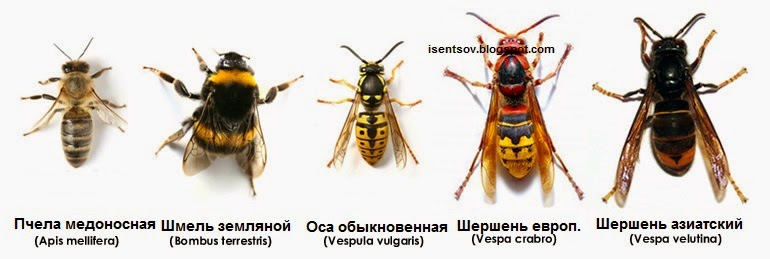
Consider the insects a little closer. Bumblebee is a chubby, fluffy, flying and buzzing insect that does not bother anyone.
A bee is a small, unobtrusive, discreet and very useful to humans insect, very furry.
The Hornet is a blood-yellow giant killer, before which everyone trembles.
Let's consider each insect in more detail and as we will see each of them has its own face:

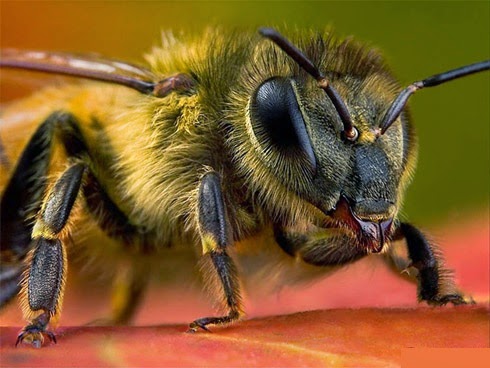
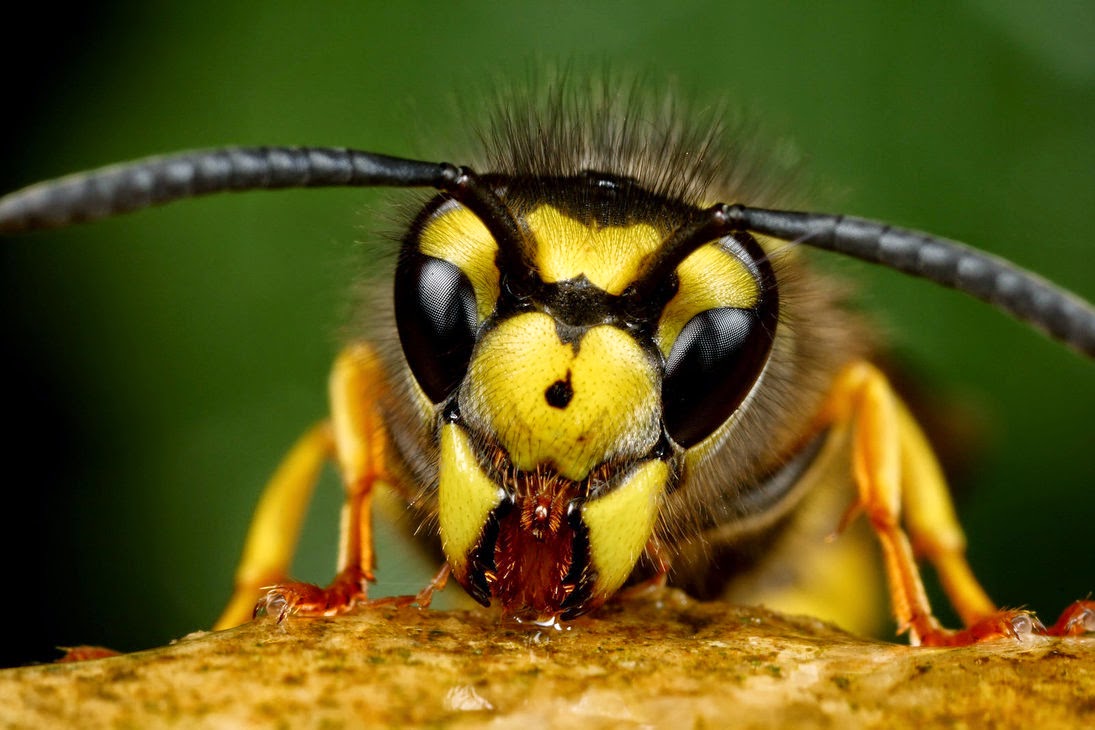
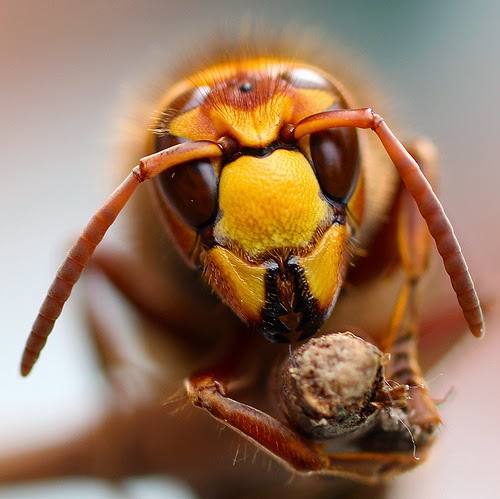
Insects differ in the way they eat. Bees and bumblebees feed only on nectar and pollen of flowering plants, for which they are equipped with a long proboscis for pumping nectar from plants and numerous hairs on the body.
Wasps and hornets are omnivorous predator insects that have an important ecological role. They can eat nectar, berries, vegetables, and other insects. Adult wasps visit the places where sap comes out on tree trunks (in particular, elm and aspen), and the inflorescences of various plants - the calf (Cirsium sp.), Seed parsnip (Pastinaca sativa L.).
Often, wasps are classified as agricultural pests: wasps on grapes. However, in urban areas the food spectrum is expanding significantly - here wasps visit markets with open trays (berries and fruits), points of sale of kvass, food waste, consume jam, etc.
To feed juveniles, working wasps actively catch various small insects, including bees, but mainly small Lepidoptera caterpillars, various dipterans (Diptera), in particular flies - Eristalis (Eristalis tenax L.), green carrion flies (Lucilia sp.).
In urban conditions, as in the extraction of carbohydrates, the range of protein sources expands - wasps do not disdain meat products (in particular, cooked sausage, decommissioned meat, etc.).
Hornets are predators and feed on various insects: gadflies, bees, flies, horseflies. ... They like to feast on tree sap, flower nectar, fruits and berries.
However, it is worth noting that the danger of hornets and wasps for bees is greatly exaggerated. Wasps and hornets are cleaners, they eat the weakest bees, but in addition, they clean nature from much larger pests: flies, butterflies, etc.
All insects differ in their method of defense / attack. Bumblebees, bees, wasps and hornets have a formidable sting weapon. However, not everyone is willing to use it.So, for bumblebees, females and working bumblebees have a sting, but they very rarely use it.
Although the bumblebee sting is almost smooth and he can use it repeatedly.
Wasps and hornets in the process of evolution have developed a more advanced weapon - a predator sting, which is also equipped with notches, but these notches are smaller than bees, and most importantly there is no peculiar knot on the tip of the sting, which allows wasps and hornets to sting many times. A comparison of the sting of a wasp and a honey bee is below:
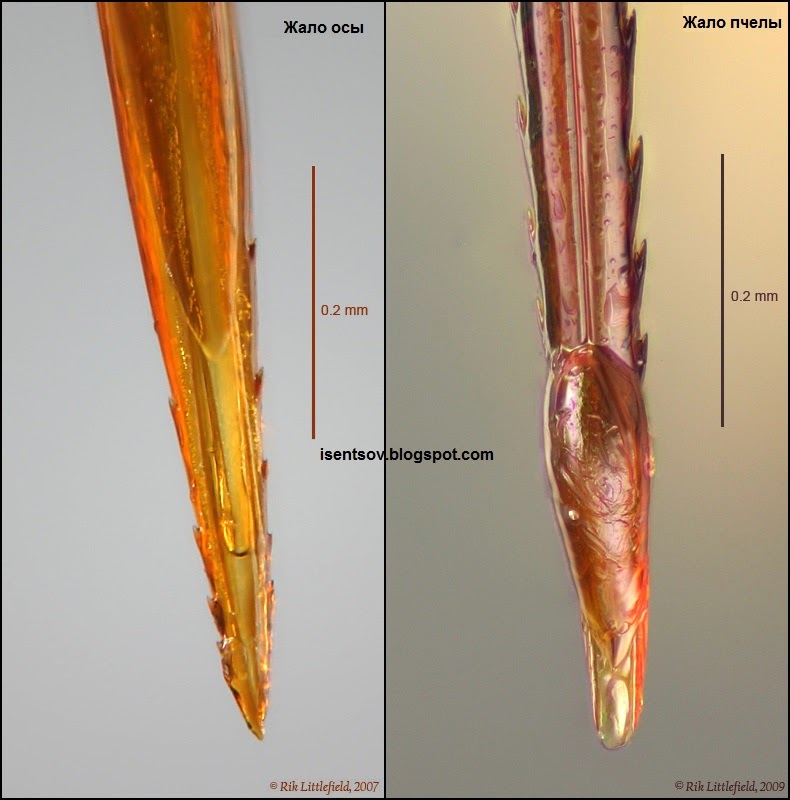
Insects differ in the structure of other organs and the general anatomy, but this is too big a topic and not very popular to be considered on the pages of this blog.
You can find out what kind of insect you see lives near your house without even seeing this insect. Just look at his nest.
How to distinguish a bee from a wasp?
Bees and wasps are very similar insects, so it is important to know how to distinguish a wasp from a bee. Bees are hymenoptera, and wasps do not have a scientific classification. Externally, the bees have a rounded little body of striped color. As a rule, the strips are black and muffled yellow, brownish.
In the wasp, the body is elongated and pointed, and the stripes are much brighter. Also, in bees, the body is furry, but in wasps it is not. The main difference between a bee and a wasp is that the latter do not carry honey.
Wasps, for example, exterminate really harmful insects, and wasps feed the future offspring with them. Both wasps and bees can sting. True, bees are not so often found in the city, as they live near flower fields.
By the way, about 80% of all plants are pollinated solely thanks to bees. A bee can sting only once in a lifetime, since there is a hook on the tip of its sting, because of which it cannot get a sting out of the victim’s body.
Wasps can sting many times, and they also bite their jaws.
The semantics of the names of the varieties of wasps and bees are quite fascinating. For example, public wasps are called that way because they live in a whole society, with their charter and hierarchy. Also, these wasps are called paper, as they build their houses from paper.
Amazingly, wasps themselves produce paper. With their strong jaws, wasps gnaw at the wood, chew it, dilute it with saliva, and get paper.
A honey bee is called that for obvious reasons. There are also bee masons who build their houses out of real cement.
Bees rarely fly into human habitation, as they feed exclusively on pollen. Wasps are attracted to human food: honey, fruits, juices, and even the meat they carry to the larvae.
Aspen poison contains alkali, and it must be neutralized with acid, for example, vinegar. Bee venom is even useful, as it is able to treat diseases of the nervous and circulatory systems. It also increases the level of hemoglobin in the body.
Despite the fact that the bites of these insects are quite painful, they rarely cause complications and problems. The only exception may be an allergy to the components of bee and aspen poisons.
Bees rarely bite just like that, but wasps can attack first, because by nature they are predators. In addition to honey and poison, bees produce useful and necessary wax for humans. Wasps destroy insect pests, for example, flies. That is why these insects should be protected.
Honey bee and common wasp
Arthropod insects, bees and wasps have their own characteristics associated with the structure of the body, the habitat. What is the hierarchy in a bee or aspen family, how many insects live, what factors affect life expectancy, what is their sting intended for?
Insect Overview
The first mention of bees was recorded 15 thousand years ago, and reports of the uniqueness and mystery of communication between insects go back to the 17th century. In those days, the fact was established that the transmission of information and the language of bees lies in dances, which are distinguished by special movements, flight speed and buzzing force.
Among wasps, solitary living and collective species are found equally. Therefore, biologists consider the wasp to be the most convenient object for studying the way of life of animals and the transition from solitary existence to colonial, and then to social interaction with the hierarchy.
Bees form a family, which is represented by 3 types of insects: the uterus, the working bee and the drone. Individuals differ in size and shape. The body structure of the insect forms:
- head;
- abdomen;
- chest;
- hard, flexible chitinous cover (external skeleton).
They are considered the descendants of ancient wasps, from which at a certain stage of development certain abilities were acquired or lost. Unlike wasps, where the uterus is obliged to take care of itself on its own, in the bee family it is surrounded by comprehensive care from the whole family.
Structural features
The main difference between a bee is the presence of a triangular head with the main part of the nervous system and brain concentrated in it. In the middle of the head, along the crown of the head, there is a suture from which complex (faceted) eyes of the insect are located on both sides.
A branched nerve approaches each tube from below. The eye of a working insect consists of 4-5 thousand facets, the uterus - up to 5 thousand, and the drone - up to 6-8 thousand. Simple eyes are on the crown of the head, and the so-called third eye is on the line of the epicranial suture. The peculiarity of the structure of the organs of vision is in the form of transmission and processing of external information.
The wasp has 2 pairs of membranous wings, and its body is 1.5 cm to 10 cm in size. On the sides of the wasp’s head are 2 large and complex eyes, giving the insect the ability to see simultaneously in different directions.
Below on the front side is the forehead, from which 2 mobile jointed antennae (antennas) extend.
The olfactory organs are located on them, designed to orient them in a dark space. With the antennae, the insect perceives humidity, temperature, and the level of carbon dioxide in the nest.
On the head of the wasp there are antennae that perform the following functions:
- remote and direct perception;
- measuring the size of cells during the construction of the nest;
- taste buds.
The insect has 3 pairs of legs attached to the lower part of the chest and consisting of 9 segments. The foot itself is formed of another 5 parts interconnected by a chitinous film. The wings of a bee consist of membranes and are supported by the veins in a taut state, and when flying, they are perpendicular to the body.
Anatomy
The anatomical structure of a bee consists of organs:
- digestion;
- breathing
- lymphatic system;
- genitals that are in the abdominal part.
In a honey bee, the abdomen has the shape of an egg, in the uterus - oblong, and in drones - with a blunt end. It consists of segments, which are a ring of 2 halves. Drones have 7 segments, the rest have 6.Between the last segments there is a pituitary device.
The internal structure of the bee in the context is as follows: a series of glands, vessels, nodes, food organs. A feature of the structure of the respiratory system is the presence of air sacs without the chitin lining inside and the tracheal system with holes in the rings, which open depending on the condition of the insect and the degree of its load.
The nervous system of a bee consists of such parts:
- central;
- peripheral;
- vegetative.
The weight of a bee depends on the functional responsibilities in the family. For a honey bee, it is 0.1 g, and the uterus is 0.25 g.
The wasp's mouth apparatus, unlike a bee, is designed to grind the plant matter that insects use to build nests or for food.
Insect sting
The bee sting has small notches, due to which it always remains in the body of the victim. If you look at the sting of a bee under a microscope, then you can see a chitin stylet with a thickening in the form of a saw at the proximal end. Inside the stylet are 2 lancets.
Wasps, hornets, ants also use a sting. This organ is a modified ovipositor and is located behind the abdominal region. The sting is a pointed organ and part of the body. With it, a wasp or bee injects a toxic substance under the skin.
After a bite, an open mortal wound forms at the place where the bee stings. It can be stung not only by the melliferous, but also the uterus, if necessary, to protect the family from attack and to fight another's uterus.
The main differences in the structure of the wasp and bee stings:
- the wasp sting has small notches;
- the wasp has no knot at the tip of the sting;
- the bee leaves its sting in sacrifice and dies;
- a wasp can sting several times.
How to distinguish a wasp sting from a bee sting? In case of danger, the bees never attack first, but sting solely for self-defense, and die after a bite.
Wasps are aggressive insects, they are annoying and can sting at the most unexpected moment.
Unlike bees, with an external threat, wasps use not only a sting, but also a jaw. A wasp sting is very painful, and in the presence of an allergic reaction in humans can be dangerous.
Insect nutrition and habitat
Among wasps, predators and herbivores are distinguished. Depending on the type of wasp, they feed very diversely: aphids, pollen, nectar, insects, fruit juice. Predatory wasps catch their prey and paralyze with the help of poison.
Wasps live everywhere, not found only on the Arabian Peninsula, the Arctic and the Sahara. The conditions necessary for the life of bees differ markedly: for insects, plant resources with fruit trees, pastures, fields with industrial and grain crops (sunflower, buckwheat) are needed.
Productivity in collecting honey largely depends on the number of brood grown by workers. The flight speed of a bee with a filled goiter is 30-40 km / h. With intensive work, the amount of nectar collected by the bee family is 10-12 kg.
A working bee makes 26 sorties per day. Bee mass is not stable.During the first flight, the bee weighs 0.122 g, in flight - 0.120 g, and the old flight - 0.108 g.
The life span of a bee born in autumn can be 7-8 months, and summer - up to 6 weeks. But the life span of insects can be regulated if the family for some reason has lost its uterus.
The difference between a bee and a wasp is not only external. By their way of life, bees are toilers working for the benefit of the family. Collecting nectar from flowers, they produce many useful products:
- honey;
- breast milk;
- wax.
Many of them are used in the pharmaceutical industry (bee venom). Wasps are not able to produce useful products, and they build their honeycombs from waste.
Bees feed exclusively on pollen, and the diet of wasps is diverse and includes an abundance of foods. Very often in the garden they can be found on ripe apples or peaches, and inadvertently stung.
What is the difference between wasps and bees
Have you ever wondered how a wasp differs from a bee? It is not easy to distinguish between these two types of insects. This article will help to clearly distinguish between wasp and bee.
Wasps are stalked hymenoptera insects. Outwardly, the wasp is not as thick as a bee's hairline. This is because the wasp does not collect pollen.
Unlike bees that prefer plant foods, wasps feed their offspring with insects, especially spiders. Mature wasps feed on flower nectar and the blood of victims. Wasp larvae can consume solid food.
Usually there are two types of wasps: solitary and public. Single wasps do not build nests. The female searches for food in the ground, for example, beetle larvae, paralyzes them and lays eggs on them. But most species of wasps still build nests.
A mink in the ground or a clay house can serve as a nest. Some species paralyze several larvae at once, thus obtaining something like honeycombs. In each cell there is a larva that feeds on insects paralyzed by the female.
Burrowing wasps differ from other species in their special behavior. They feed offspring with various insects, and build nests in the stems of plants, for example, blackberries, and aphids fill chambers for larvae.
This type of feeding is also distinguished as a “one-time allowance”: a wasp digs a mink in the ground, about 5 cm deep, which at the end expands to the larval chamber, the wasp lays several small caterpillars in the chamber, and then lays eggs on them.
The larva grows and feeds on caterpillars, then forms a cocoon, and a full-fledged individual emerges from the cocoon, pulling its own way up.
Public wasps live in colonies. They build their houses from cells that are hung on a special leg to the walls and cornices of buildings, as well as to tree branches.
These cells look like paper and are made from chewed grass and wood. Social wasps are divided into egg-laying, who are also called queens, and working individuals who do not lay eggs.
The uterus usually builds one cell and immediately lays an egg in it, then gradually the rest are built around the first cell. The uterus feeds the hatched larvae with chewed insects. During feeding, the larvae secrete saliva, which is taken by adults.
After that, the cell is cleaned and used for another larva. Larvae usually ripen at the end of summer, some survive the winter, falling into a daze, while others die.
Some species of wasps in the south of the United States lay honey in cells.
Bees, like wasps, are classified as hymenopteran. The body of the bees is black with yellow spots, more stocky than the wasps, the hairline is thicker. Unlike wasps, both larvae and adult bees only eat plant foods: pollen and nectar.
Some bees in the process of evolution have developed such a useful quality as pollination of flowers of only one species. The main benefit of bees is not honey and not wax, but their ability to pollinate. Honey bees can be moved from place to place so that they pollinate agricultural products.
Like wasps, bees are social, semi-public and solitary. Most bees are solitary. Some of them dig minks in the ground, some live in the stems of plants and in the crown of trees.
A bee breaks a mink from the inside with a thin layer of wax, then brings pollen and nectar there, lays eggs on top and closes the entrance to the mink with stone or earth. After which the bee begins to build a new cell.
Bee larvae feed on nectar and pollen, having formed, become either a chrysalis, from which a full-fledged individual then emerges, or remain in a larval state for a very long time. Those species in which the larval stage is short lived in nests.
An interesting way to spend the night bees: usually males gather for spending the night in a swarm on the stems of plants and interlock with their jaws.
Semisocial bees build several nests nearby, each of which is often occupied by more than one bee. Interestingly, in this case, each bee feeds only its offspring. You can often see guard bees outside the hive.
Bumblebees - representatives of public bees, differ in large size, bright yellow color and especially long hairs on the body. Young bumblebee individuals appear in the fall, with the onset of winter, males die, and the uterus is buried in the ground to winter.
Non-stinging bees are also isolated. Since the sting is a modified ovipositor, accordingly, only females can sting, and in some bees, the sting is simply reduced.
An interesting phenomenon is the robber bees. On their hind legs there are no baskets for collecting pollen, they do not pollinate flowers, but are engaged in capturing and remaking other people's nests in order to obtain food.
Bee honey is nectar, partially digested by a bee, which it burps into a honeycomb. The bee seals the honeycomb with a special wax layer. Wax is secreted in bees from special glands.
Output:
- Externally, a wasp differs from a bee in a more slender body and a less dense hair.
- Wasps do not collect pollen and do not pollinate plants, unlike bees, whose main purpose in nature is to pollinate flowers.
- Since the bees are pollinators, they have special devices for pollination in the form of baskets on the leg, in which pollen is carried.
- Wasps feed their larvae with animal food, and bees only plant.
- Wasps paralyze prey, bees bring their “fresh” caterpillars to their offspring.
- Bees produce honey, while only some species of wasps can do this.
- Bees cover the inside of the mink with a thin layer of wax, and wasps do not give off wax.
- Bees build beehives from wax, and wasps make their chambers from a chewed mixture of wood and grass that resembles paper.
- Representatives of public bees settle in minks, abandoned by rodents and in bird nests, and public wasps build their own houses.
Differences and similarities of wasp, bee, and bumblebee
It is rather difficult to distinguish the differences between a bee and a bumblebee, and the similarities of insects, at first glance, are also not all visible. The initial similarity of these three species, which determines their common gene, these yellow-black insects belong to the order Hymenoptera, they are all equally useful for agriculture.
And one more similarity, which is first of all remembered by a sane person - a sting. More about this weapon, sometimes fatal to the victim, will be discussed later. Now about each minke whale in more detail.
Appearance
Externally, bees, wasps and bumblebees have quite striking differences. The largest bumblebee of this trinity, it is quite furry, so its size is almost three times the size of an ordinary labor bee and wasp. The coloring of the bumblebee is much brighter than that of a bee, but not inferior to the wasp in terms of light.
Nests and honeycombs
This paragraph indicates more likely differences between these representatives of membranous-winged, rather than their similarity. The residence of domestic bees is the hives of the creation of human hands. Wild bees live in hollows of trees.
The honeycomb shape of bees and wasps have a neat symmetrical appearance. Their honeycombs of a symmetrical shape look larger than nests of bumblebee larvae arranged in a row.
Bees live in rather large families several times the number of members of the bee family. The latter simply do not need such a mass of bee showers since they are inactive in winter, unlike bees that keep their pace in the cold season.
Do wasps and bumblebees make honey
As for honey, the bee and bumblebee compositions are different. In the composition of liquid bumblebee honey, the amount of sucrose proteins and minerals is twice as large as in the bee product.
And he, in turn, has an advantage in the shelf life regardless of air temperature. Bumblebee honey is stored only in the refrigerator, otherwise it will soon ferment.
Wasps, unlike bees and bumblebees, do not collect nectar and pollen do not produce honey. They participate in pollination indirectly and not always if they accidentally find themselves on a flower to find prey for their larvae (aphids and other small insects).
Wasps are also different from their honey bears in that they feed the larvae with animal food, whereas in bees the offspring grows on pollen and nectar.
Means of self-defense of striped honey plants
Each of the insects described above has its own way to protect against danger, but the control tool has a single name. The bee sting after the attack remains in the victim’s body, and the brave toiler dies after losing this part of her hymenoptera.
The danger of a bee or bumblebee bite increases at times for people prone to allergies to substances secreted by these insects. You should be careful when you are among the flowers, since the probability of meeting and offending a bee is quite high. Do not risk your health and life.
Vegetarians and predators
Honey bee (Ápis melliféra) - a public insect that lives in families in which the duties of all members are strictly regulated.
The head of the family is the female - the queen bee.The body of the insect consists of 3 sections - the head, chest and abdomen, and is covered with the finest chitinous hairs.
Honey bee
The bee is an absolute vegetarian, feeds on nectar, plant pollen and honey, which is fermented nectar. To collect and carry nectar, she has a proboscis and a special goiter. Pollen collection occurs due to hairs on the body and brushes or scallops on the legs.
In this case, the honey producer cannot pull out the sting, leaves it in the skin of her victim along with part of the intestine, and dies. 100-200 of such attacks cause severe poisoning in a person, more than 500 - death.
Man uses not only the vital signs of these amazing creatures - honey, bee bread, propolis, wax, but also bee venom. Its healing properties are so high that on its basis a whole medical industry has developed - apitherapy.
The poison for the treatment of a wide range of diseases, primarily diseases of the musculoskeletal system, is used as part of medicines, as well as in its pure form. To do this, an insect is applied to a sore spot so that it stings. Treatment is carried out under the strictest supervision of a doctor.
Bumblebee
Bumblebee (Bombus) - a relative of Ápis melliféra, belongs to the same family. This is a large, thick, shaggy hymenoptera: the female reaches 28 mm in length, the male - 24 mm. It is also a public insect living in small families of up to 100 individuals.
The nests are located close to the ground, under the moss or between the stones and consist of honeycombs made of coarse wax or empty cocoons.
It feeds on Bombus nectar and pollen, and also produces honey. Bumblebee honey in many respects exceeds the product produced by the inhabitants of apiaries, but it is impossible to collect it in sufficient quantities - insects do not stock up, since the family does not have to winter.
He is an unsurpassed pollinator. Employees of greenhouses are trying to attract him to their farms in order to improve the fruitfulness of plants.
The sting of this hymenoptera is hollow, without nicks, and only females can use it repeatedly. The insect is not aggressive, it stings very rarely, but painfully. Edema, numbness develops at the site of the lesion.
The external difference of the well-known paper wasp from the honey bee is visible to the naked eye: the body of the first is slender, smooth, the breast at the place of articulation with the abdomen is thinning, the body of the second is more rounded and furry.
Wasp
The wasp in accordance with the entomological classification is a representative of a special family, which includes many species. In our strip, the most common were Vespids, or the paper variety.
In the nest, the female builds a honeycomb and lays eggs there. Later, larvae hatch from them. If the uterus is removed, the working individuals begin to lay eggs. The number of inhabitants of the nest per season can reach several hundred, but in winter most of them will die.
Fertilized females survive the winter, and in the spring they establish new colonies. The main difference between the Vespids and the inhabitants of the hives is in the food system.
The builders of paper nests, like most varieties of the aspen family, are predators. Moreover, adults feed on flower nectar and fruit juice, but their larvae require protein food.They chew on flies, butterflies, pieces of meat, perishable fish or carrion and so feed their larvae.
The sting of these hymenoptera is hollow inside, has no notches and is at the same time an ovipositor. It does not get stuck in the skin of a mammal, and its owner can sting several times. The thin “wasp waist” contributes to the fact that the hymenoptera can be folded almost in half and strike in any position.
The poison is much more allergenic than the poison of the inhabitants of apiaries, it causes severe pain, swelling and destruction of cells, especially in the case of an attack on the face - nose, eyes, mouth. Sad statistics confirm that every year several dozen people in the world die due to hornet attacks.
These stalked bellies are equipped with powerful jaws with which they inflict painful bites.
Hornet giants
The danger increases if a person or animal is attacked by a hornet - the largest species of the wasp family. In a temperate climate, the working individual reaches 25 mm, and the uterus -35 mm.
They are one hundred percent predators, feed on other arthropods and feed the larvae with them. Also include fruit juice in their diet, do not ignore honey. For this reason, adult individuals cause great damage to apiaries, destroying their toilers and robbing hives.
The severe consequences of injecting poison are not explained by its quantity, but by increased allergenicity. Only females that can sting repeatedly are provided with a three-millimeter sting.
The poison contains histamines, toxins, the substance acetylcholine and other components that cause irritation of nerve fibers, palpitations and severe pain. An allergic reaction in this case is accompanied by severe edema and can have unpredictable consequences.
They are much less common than the same Vespids, and less aggressive, the first to not attack. However, such a neighborhood in a country house or cottage is highly undesirable - an accidentally disturbed nest can turn into a tragedy.
In wildlife there is nothing useless - each species, including the predatory one, occupies the necessary ecological niche.
And yet, if aspen, and even more so, a hornet colony was found near human habitation, all measures must be taken to get rid of it.
leave a comment